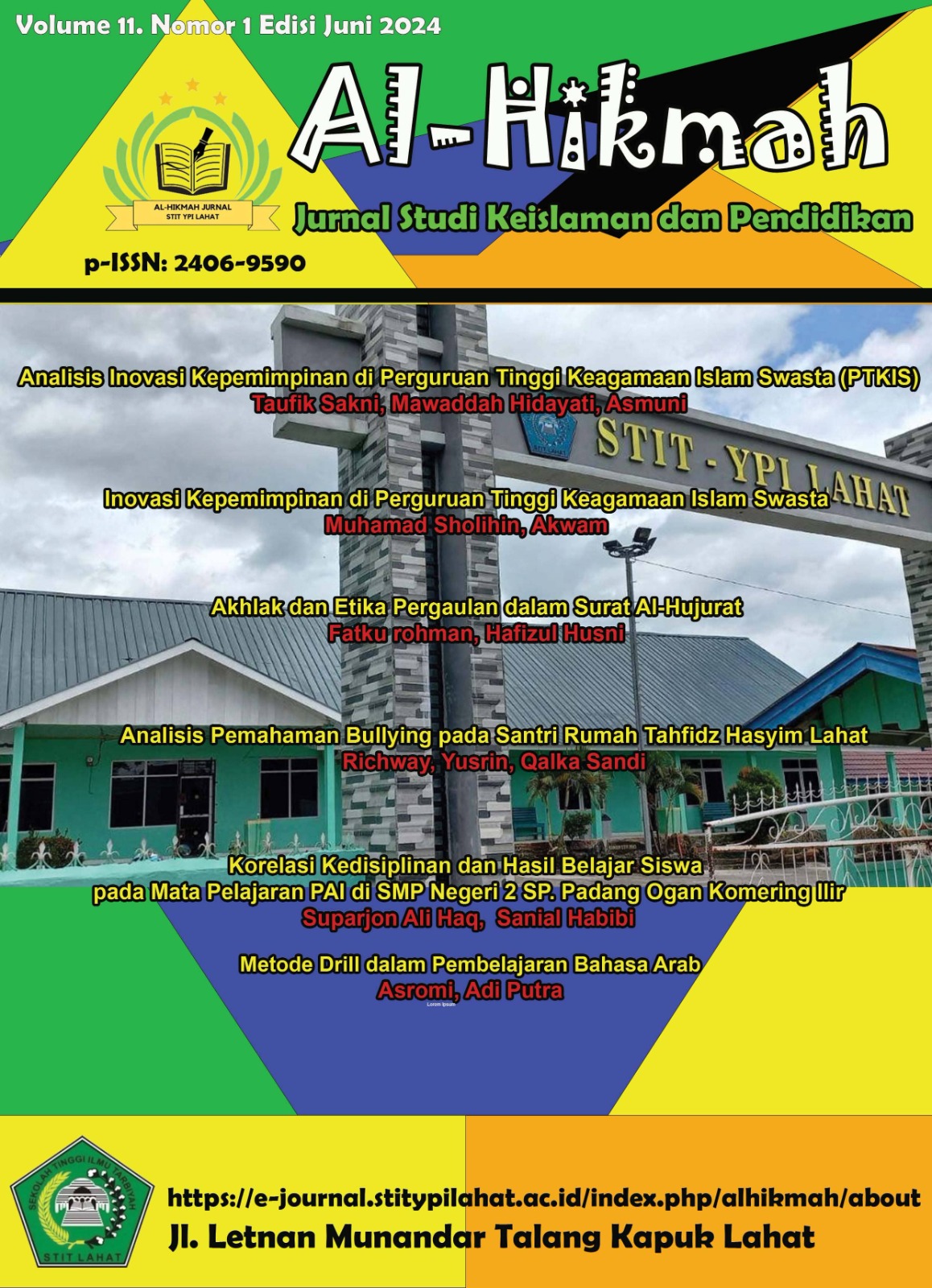Analisis Pemahaman Bullying pada Santri Rumah Tahfidz Hasyim Lahat
Main Article Content
Abstract
Artikel ini bertujuan untuk menganalisis pemahaman dan pengalaman santri di Rumah Tahfidz Hasyim Lahat terkait bullying, serta bagaimana lingkungan rumah tahfidz mempengaruhi dinamika bullying. Penelitian ini menggunakan pendekatan kualitatif dengan metode studi kasus. Data dikumpulkan dan dianalisis menggunakan teknik Miles dan Huberman. Hasil penelitian menunjukkan bahwa santri di Rumah Tahfidz Hasyim memiliki pemahaman yang baik tentang bullying dan berbagai bentuknya. Mereka mengenali bullying sebagai tindakan yang merugikan dan mengakibatkan dampak negatif pada korban. Lingkungan rumah tahfidz terbukti sangat mendukung dalam mencegah perilaku bullying melalui berbagai kegiatan yang mempromosikan nilai-nilai positif seperti kebersamaan, empati, dan saling menghormati. Meskipun diskusi tentang bullying di antara santri tidak sering terjadi, mereka merasa nyaman melaporkan insiden bullying kepada pengajar. Pengajar di Rumah Tahfidz Hasyim memberikan dukungan yang signifikan dengan menanggapi laporan bullying secara serius dan menciptakan lingkungan yang aman dan mendukung. Penelitian ini menyimpulkan bahwa pemahaman yang baik tentang bullying di kalangan santri, didukung oleh lingkungan yang positif, dapat membantu dalam mencegah dan menangani bullying secara efektif. Penelitian ini memberikan wawasan penting bagi pengelola rumah tahfidz dan lembaga pendidikan lainnya dalam menciptakan lingkungan yang bebas dari bullying.
Article Details

This work is licensed under a Creative Commons Attribution-ShareAlike 4.0 International License.
This work is licensed under a Creative Commons Attribution-ShareAlike 4.0 International License.
References
Borualogo, I. S., & Casas, F. (2021a). Subjective Well-Being of Bullied Children in Indonesia. Applied Research in Quality of Life, 16(2), 753–773. https://doi.org/10.1007/s11482-019-09778-1
Borualogo, I. S., & Casas, F. (2021b). The relationship between frequent bullying and subjective well-being in indonesian children. Population Review, 60(1), 26–50. https://doi.org/10.1353/prv.2021.0002
Borualogo, I. S., & Casas, F. (2023). Bullying Victimisation and Children’s Subjective Well-being: A Comparative Study in Seven Asian Countries. Child Indicators Research, 16(1), 1–27. https://doi.org/10.1007/s12187-022-09969-7
Erreygers, S., Vandebosch, H., Vranjes, I., Baillien, E., & De Witte, H. (2018). The interplay of negative experiences, emotions and affective styles in adolescents’ cybervictimization: A moderated mediation analysis. Computers in Human Behavior, 81, 223–234. https://doi.org/10.1016/j.chb.2017.12.027
Freska, W. (2023). Bullying dan Kesehatan Mental Remaja. CV. Mitra Edukasi Negeri.
Man, X., Liu, J., & Xue, Z. (2022). Does Bullying Attitude Matter in School Bullying among Adolescent Students: Evidence from 34 OECD Countries. Children, 9(7), 9070975. https://doi.org/10.3390/children9070975
Manesis, N., Chatzidaki, N., & Gialamas, M. (2022). Applying De Bono’s six thinking hats for an anti-bullying program. Journal of Education and Learning (EduLearn), 16(4), 440–447. https://doi.org/10.11591/edulearn.v16i4.20545
Martínez-Carrera, S., Sánchez-Martínez, C., Martínez-Carrera, I., & Dieguez, M. Á. D. (2024). Teachers’ Perceptions and Position Regarding the Problem of Bullying and Its Socio-Educational Prevention. Behavioral Sciences, 14(3), 14030229. https://doi.org/10.3390/bs14030229
Piazuelo-Rodríguez, I., Bautista-Alcaine, P., Cebollero-Salinas, A., & Íñiguez-Berrozpe, T. (2024). Family and peer support as a preventive factor of cyberviolence among teenagers. Implications according to age and gender. Aloma: Revista de Psicologia, Ciències de l’Educació i de l’Esport, 42(1), 37–48. https://doi.org/10.51698/aloma.2024.42.1.37-48
Rębisz, S., Jasińska-Maciążek, A., Grygiel, P., & Dolata, R. (2023). Psycho-Social Correlates of Cyberbullying among Polish Adolescents. International Journal of Environmental Research and Public Health, 20(8), 20085521. https://doi.org/10.3390/ijerph20085521
Savahl, S., Adams, S., & Hoosen, P. (2024). Children’s Experiences of Bullying Victimization and the Influence on Their Subjective Well-Being: a Population-Based Study. Child Indicators Research, 17(1), 1–29. https://doi.org/10.1007/s12187-023-10084-4
Segovia-González, M. M., Ramírez-Hurtado, J. M., & Contreras, I. (2023). Analyzing the Risk of Being a Victim of School Bullying. The Relevance of Students’ Self-Perceptions. Child Indicators Research, 16(5), 2141–2163. https://doi.org/10.1007/s12187-023-10045-x
Shu, Y., Suzuki, S., Ota, M., & Kato, H. (2024). Relationship Between Bullying Victimization and Normative Beliefs About Aggression: The Japanese Journal of Educational Psychology, 72(1), 40–56. https://doi.org/10.5926/jjep.72.40
Suparwi, S. (2015). Perilaku Bullying Siswa Ditinjau Dari Persepsi Pola Asuh Otoriter Dan Kemampuan Berempati. Inferensi, 6(2), 159. https://doi.org/10.18326/infsl3.v8i1.159-179
Theodora, M., Sahrani, R., & Roswiyani, R. (2023). The mediating effect of forgiveness on the relationship between spirituality and psychological well-being in adults with history of childhood bullying. 8(2), 241–258. https://doi.org/10.21580/pjpp.v8i2.17829
Wu, X., Zhen, R., Shen, L., Tan, R., & Zhou, X. (2023). Patterns of Elementary School Students’ Bullying Victimization: Roles of Family and Individual Factors. Journal of Interpersonal Violence, 38(3–4), 2410–2431. https://doi.org/10.1177/08862605221101190
Yang, K. H., & Lu, Y. (2024). Combating school bullying through multi-role experience-based virtual scenario learning model: Assessing empathy, problem-solving, and self-efficacy from a multi-stakeholder perspective. Heliyon, 10(10), 31044. https://doi.org/10.1016/j.heliyon.2024.e31044
Zhao, B., Guo, J., He, Q., Jiang, L., & Hu, W. (2023). School Bullying Victimization Types of Primary School Students and Associations with School Adaptation: a Latent Profile Analysis. Child Indicators Research, 16(2), 755–775. https://doi.org/10.1007/s12187-022-09995-5

